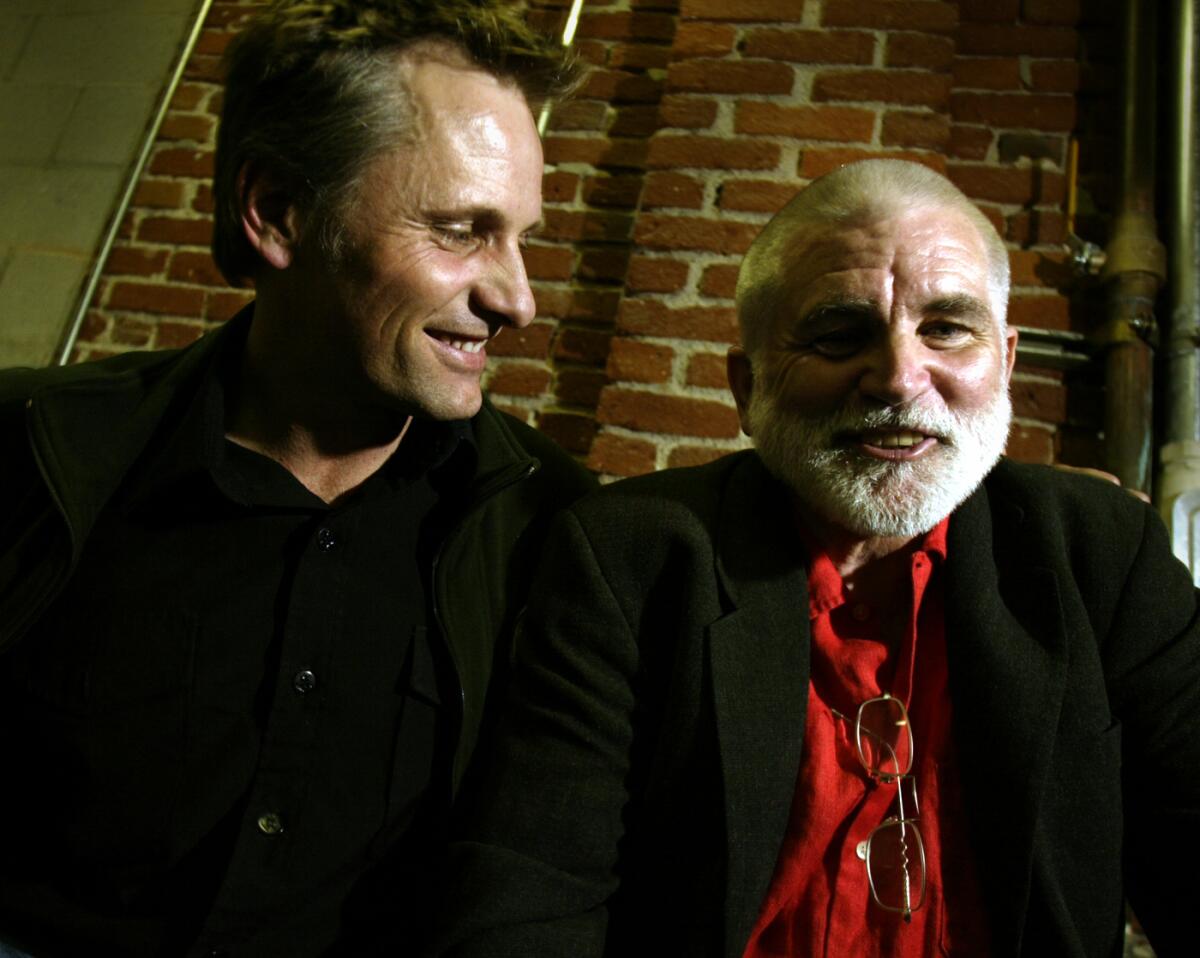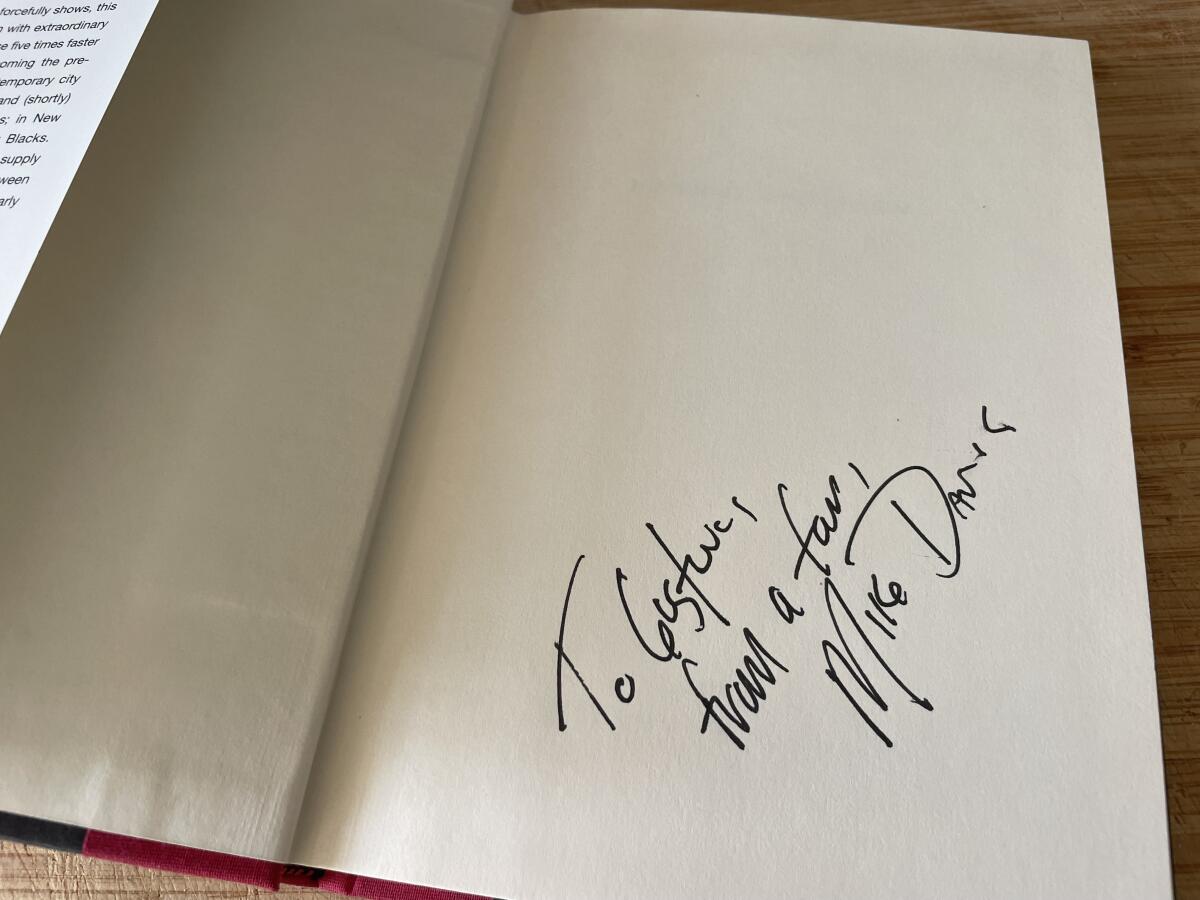Column: Mike Davis has terminal cancer. But his big worry is what is happening to our world

- Share via
SAN DIEGO — You can easily understand why Mike Davis might be glum.
The Jeremiah of Southern California — the writer equally hailed and hated for decrying the dark side of the region’s eternal boosterism — has battled cancer for the past five years.
He recently decided to stop chemotherapy and is now at his San Diego home on palliative care. Doctors have given him months to live.
The recent COVID surge has slowed the torrent of activists and academics stopping by to say their goodbyes. He came out with a new book last year but now has to reject the multiple writing requests coming his way.
I wasn’t expecting a quick response when I emailed him asking for an interview — but he immediately replied.
A Facebook post announcing his fate “gave many people the impression that I was imminently at death’s door,” he wrote. “In fact I’m in fine spirits, surrounded by love, ridiculously pampered, and managing discomfort with a little morphine.”
Early in my career, I went to a reading for his underappreciated 2000 book “Magical Urbanism: Latinos Reinvent the U.S. City,” which he signed for me with the note, “From a Fan.” His kind words inspired me to adopt his ultimate lesson — you can’t really love a place without pointing out its sins.
And boy, is right now the time for that.
Environmental calamities abound, as he predicted in his 1998 book “Ecology of Fear.”
Pandemics are now part of daily life, not a once-in-a-generation rarity, as he detailed would happen 17 years ago in “The Monster at Our Door: The Global Threat of Avian Flu.”
Racial and urban strife is endemic yet again, as he foreshadowed in his most famous tome, “City of Quartz,” which published two years before the L.A. riots and is considered a modern-day classic even by detractors.
We’re living in a world Davis warned us about — and he takes no joy in that.
I asked Davis to chat for about an hour, expecting bromides and castigations against the powers that be. He gave me so much more.
It’s not often that a personal icon lets you kick it with him for the better part of an afternoon, when he has so little time to spare.
Book: Supporters praise ‘Ecology of Fear’ as brave. Others condemn author’s research and accuracy.
Davis, 76, sat on a couch, his wife — artist and professor Alessandra Moctezuma — by his side. He wore a T-shirt with a Celtic harp encircled by the words “Unrepentant Irish Bastard.”
He was gaunt, but his eyes and voice and intellect were as fierce and clear as ever. His trademark white beard and short-cut hair shone with the vigor of life not yet ready to be left.
I had some questions but set them aside as we chatted for hours. He lectured on the Okie old guard of Bell Gardens and deemed Joe Biden a “sheer disaster.” I informed him of the latest ongoings with L.A. County Sheriff Alex Villanueva. There was a funny memory about former L.A. Mayor Richard Riordan, and war stories from his days as an activist. We both agreed that the novelist William Saroyan is an unappreciated genius who’ll probably never experience a renaissance.
He bore no ill will for his many critics despite years-long campaigns painting him as little better than a fact-twisting civic Eeyore. Nor did he take satisfaction that most of them now lie in the dustbins of history while he is more celebrated than ever, as humanity goes to hell.
“What — as a good communist I should have taken pride being attacked by all these people?” Davis remarked at one point. “I’m not really that concerned about vindication and any of that.”
But the man this newspaper once said “isn’t so bad,” at the same time it cut him down in a nearly 6,000-word front-page story, did admit he’s more worried than perhaps he has ever been.

Early in our conversation, Davis showed me a photo of a group of men he’s known since second grade, all from the conservative “heart of darkness” that he joked was the El Cajon area in the 1950s.
“I never doubted for a moment that people could change,” he said, noting how many of those friends — all working-class whites — joined him in antiracist rallies during the 1960s. “But it’s an almost inconsolable loss to me that I know that I can’t reach these kinds of people anymore,” due to political polarization.
“Although I’m famous as a pessimist, I really haven’t been pessimistic,” he continued. “You know, [my writing has] more been a call to action. An attempt to elicit righteous anger against those whom we should be righteously angry against. But now, there is a certain sense of doom. This is not the time or history that my kids should inherit, you know?”
He gestured to his 18-year-old son, James, who had been silently reading a Nathanael West novel nearby. Before his illness, the two traveled through the backcountry of San Diego County to pursue Davis’ secret life as a rockhound and his son’s love for botany.
“What’s personally most disconcerting is that I take my brown son out to East County where I grew up ... “ Davis began. “Tell [Gustavo] what happened.”
James picked up the story. “Somebody who owns a property right next to a [public] road will get in a pickup truck, and they’ll threaten us, and they’ll tell us, ‘You better get off my damn property.’ We’re on the side of the road, a public right-of-way. It’s ridiculous. And it’s happened multiple times.”
Two hours later, it was time for lunch.

Moctezuma had laid out a spread of burritos, tacos and hummus in the kitchen. She and Davis shared stories about protesting exiled Mexican President Carlos Salinas de Gortari in Ireland, and disturbing a docent at the Alamo by revealing that Moctezuma’s ancestor killed Jim Bowie.
I knew I should’ve pressed on with profound questions, but I couldn’t. I knew Mike Davis, the legend; I was finally knowing Mike Davis, the man. I wish I had known him earlier.
We kept talking.
Did he feel driven out of Los Angeles in the wake of the backlash to “Ecology of Fear”? Nah, he gladly moved to San Diego to follow Moctezuma, who found a job at Mesa College, where she still teaches.
What did Davis think his legacy would be? He scoffed.
“I don’t think it’s possible for a writer-activist to claim to have a legacy — that will be defined later,” he said, slowly chewing on carne asada. “The important thing is being able to say that you punched the time clock every day. You did your tiny bit for social justice.”
For the record:
9:12 a.m. July 22, 2022An earlier version of this column said Mike Davis has been married to his wife since 1999. They married in 1997.
“I was just looking at your hands,” Moctezuma then said, grasping her husband’s fingers. The two have been married since 1997. “It shows that Mike writes every day. Nonstop. You have all these muscles in your hands!”
Davis blushed. “Not the hands I used to have.”
“My quality of life actually couldn’t be better,” he said. “As you can see, I’m surrounded by love in this family. And in some ways, it’s been absolutely the best period of my life … I’m not sure I would trade this time, except maybe for when we were adventurers, when we were first married.”
“We got to travel a lot,” Moctezuma replied, with a wistful smile. “Yeah. Had a lot of …” She trailed off. “You know, fun.”
The two now spend their days watching the sunset or “cuddling up, watching TV together,” Davis said, “indulging in things that feel good.”
There was nothing funereal about my time with Davis. In fact, I took with me the one bit of optimism for this country that he still maintains in the face of gloom.
Throughout our conversation, he brought up young people who send him kind letters about books he wrote when they weren’t even born.
“You have this whole generation that does not want to be a lost generation,” he said. “It wants to be the most active generation ever. Above all, the moral dimension of all these kids. They have incredible values about race or gender, and they’re naturally disposed to be fighters.”
Davis has been collecting school yearbooks for the “social history” they depict.
His prized possession: 1938 Roosevelt High.
The Boyle Heights campus was “the rainbow coalition come to life,” he said. “You talk about diversity. Oh my God. Okies, Russians, Japanese, Filipinos, Blacks. And then about 50% Mexicans.
“All these kids growing up together and kind of basking in this self-respect. ‘Don’t mess with Roosevelt High School. We’ve got all kinds of people who’ll all fight,’” he added, sounding happy and content — and hopeful.
More to Read
Sign up for Essential California
The most important California stories and recommendations in your inbox every morning.
You may occasionally receive promotional content from the Los Angeles Times.











